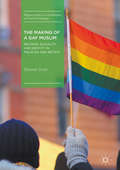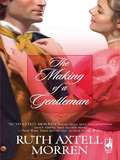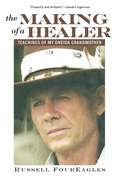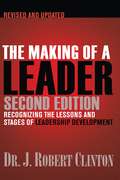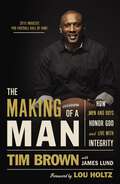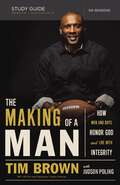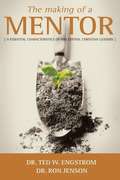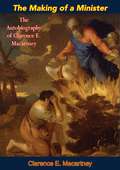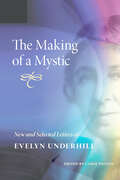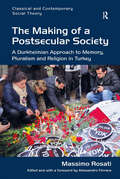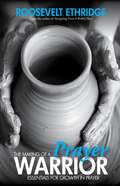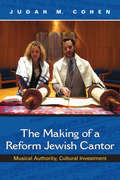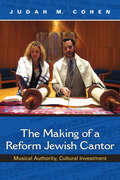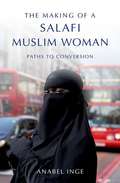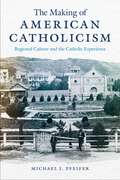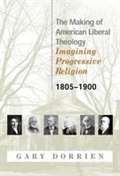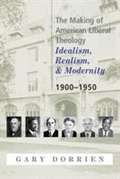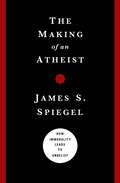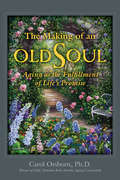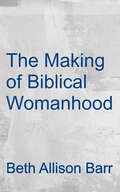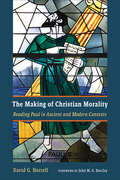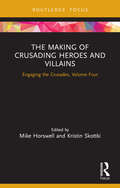- Table View
- List View
The Making of a Gay Muslim
by Shanon ShahThis book highlights the lived experiences of gay Muslims in Malaysia, where Islam is the majority and official religion, and in Britain, where Muslims form a religious minority. By exploring how they negotiate their religious and sexual identities, Shah challenges the notion that Islam is inherently homophobic and that there is an unbridgeable divide between 'Islam' and the 'West'. Shah also gained access to gay Muslim networks and individuals for his in-depth research in both countries, and the book investigates the different ways that they respond to everyday anti-homosexual or anti-Muslim sentiments. Amid the many challenges they confront, the gay Muslims whom Shah encountered find innovative and meaningful ways to integrate Islam and gay identity into their lives. The Making of a Gay Muslim will appeal to students and scholars with an interest in contemporary Islam, religion, gender and sexuality.
The Making of a Gentleman
by Ruth Axtell MorrenJust moments from the hangman's noose, Jonah Quinn escapes from infamous Newgate Prison. Taking prison volunteer Florence Hathaway hostage is a masterstroke, but Jonah intends to end their acquaintance once he's free. God, however, has other plans. The caring spinster's mission is to turn Jonah's life around. The burly fugitive scoffs at the notion he can be groomed into respectability, much less win a royal pardon. He knows that donning a waistcoat and cravats does not change a man. But a woman's stubborn faith? That can accomplish miracles. Florence sees right into the depths of his roguish heart, and Jonah finds himself wanting to become that man she sees. . . .
The Making of a Healer
by Russell FoureaglesOnce Oneida healer Russell FourEagles (Atuneyute Keya) went to see his friend Bob, whom doctors had declared incurably paralyzed following a stroke. Within minutes of FourEagles' attention, Bob was kicking the covers off the bed. "You should write a book!" Bob later encouraged. And here it is. FourEagles' grandparents escaped the reservation-school education that obliterated Native American culture, preserving the healing abilities that can be traced in an unbroken lineage back two hundred grandmothers. In The Making of a Healer, he openly shares his knowledge in an effort to keep the old wisdom and practices from being forgotten. Recounting sacred Oneida myths and cosmology, he describes the healing powers of the Fire Ceremony, energy exchange, and humor; discusses natural remedies; and explains how he healed himself from post-traumatic stress disorder after serving in the Vietnam War.
The Making of a Leader: Recognizing the Lessons and Stages of Leadership Development (2nd Edition)
by J. Robert ClintonAfter examining the lives of hundreds of historical, biblical, and contemporary leaders, Dr. J. Robert Clinton gained perspective on how leaders develop over a lifetime. By studying the six distinct stages he identifies, you will learn to: Recognize and respond to God’s providential shaping in your life; Determine where you are in the leadership development process; Identify others with leadership characteristics; and Direct the development of future leaders. This revised and updated edition includes several new appendixes and expanded endnotes, as well as an application section at the end of each chapter.
The Making of a Man: How Men and Boys Honor God and Live with Integrity
by Lou Holtz Tim Brown James LundWhat exactly is manhood? How do guys get there? Tim Brown won the Heisman Trophy at Notre Dame and starred in the NFL for seventeen seasons. He left the game as a Los Angeles and Oakland Raiders legend and one of the most respected men in sports. Now “Mr. Raider” shares his amazing journey—the triumphs, the heartbreaks, the struggles with women, Al Davis, and God—as well as the principles and priorities that made him the man he is today. Much more than a sports memoir, The Making of a Man reveals how faith, family, honor, and integrity have everything to do with true manhood and a life well-lived. Whether you are a rabid fan or have little interest in football, a young boy or already facing the fourth quarter of your life, these pages will both challenge and inspire you to become the man you’ve always known you could be. Back Cover:When a man comes into your life and shows you something about yourself that you didn’t know was in you, it’s remarkable. The Apostle Paul did that for Timothy, encouraging him to preach and teach and reminding him, “Do not neglect your gift” (1 Tim. 4:14). Paul was a mentor to Timothy, ready to point out the gifts of his protégé and willing to help develop those gifts and pass on his knowledge. Lou Holtz did the same for me, as well as for a whole lot of other guys. That’s what a mentor does. I’ll always be grateful that he inspired me to believe in myself. —Tim Brown Former Heisman Trophy Winner and NFL All-Pro “I’ve had the privilege of knowing Tim for over thirty years now. I’ve seen him beat the odds in many different areas of life, especially as a father and a mentor. I believe this book will help bring out your true greatness as you read stories about Tim’s successes and struggles, and as you’re inspired by his commitment to integrity as well as the life principles and the faith that have carried him through.” —Carey Casey, CEO, National Center for Fathering / fathers.com “Over the years, I’ve respected Tim Brown as an NFL opponent, a teammate, and a friend. In The Making of a Man, you will read what has made Tim the man he is today and learn vital lessons on what being a man is all about. Whether young or old, every guy should read this book.” —Jerry Rice, NFL Hall of Fame Wide Receiver Three-Time Super Bowl Champion
The Making of a Man Study Guide: How Men and Boys Honor God and Live with Integrity
by Tim BrownWhat Does It Take to Be a Godly Man? Every young boy dreams about what he wants to be when he grows up. Some have goals of becoming an astronaut, or a fireman, or a professional athlete. But what does it take to be a man? How does a young person get there?In this six-session video-based curriculum, NFL All-Pro, sports analyst, and businessman Tim Brown uses experiences from his life to teach men the principles and priorities he has learned for leading a life that honors God. Through his stories of struggling with God, overcoming temptations, and discovering what it takes to be a good husband and father, he shares what true manhood is all about and what guys must do to attain it. These principles have helped Tim lead a life of honor and integrity that has made him one of the most respected men in the world of sports.The Making of a Man will not only inspire men of all ages but also challenge them to measure their lives and success by a higher standard.Designedfor use with The Making of a Man: A Video-basedStudy (978-0529-11308-5)
The Making of a Marriage
by Janet ThomaThis volume gives an idea of how to understand your partner, their needs and accordingly to make your marriage successful.
The Making of a Mentor: Nine Essential Characteristics of Influential Christian Leaders
by Ron Jenson Ted W. EngstromJesus ministered to many but focused on a few. What makes this strategy so compelling? Because he understood the secret of living forward—spiritual multiplication through intentionally influencing a few people at a time. He knew that by concentrating on a few faithful men and women they would leave behind them a legacy of people whose influence would extend beyond a generation or two; in fact, a legacy that would continue to multiply until he returned. This book is written to stimulate you, whatever your age, gender or position in life, toward a passionate desire to change people who will then change other people who will change other people. The key is not so much how you pour your life into people but that you are a person worth following. God placed you here to invest your life in others. This book will show you how to live and speak truth into the lives of others in a way that will transform them forever. Some of the essential leadership characteristics discussed in this book: -Self-discipline -Encouragement -Gentleness -Confrontation
The Making of a Minister: The Autobiography of Clarence E. Macartney
by Clarence MacartneyOriginally published in 1961, The Making of a Minister is Clarence E. Macartney’s autobiography—the story of a man who was a great preacher, a Civil War scholar, a skilful and prolific writer, and the leader in the evangelical movement in its time of greatest crisis….A ‘minister’s minister,’ who, personifying the highest ideals of his calling, was also and foremost a ‘folk’ minister, with the compassionate heart of a true shepherd.
The Making of a Mystic: New and Selected Letters of Evelyn Underhill
by Evelyn UnderhillEvelyn Underhill (1875-1941) achieved international fame with the publication of her book Mysticism in 1911. Continuously in print since its original publication, Mysticism remains Underhill's most famous work, but in the course of her long career she published nearly forty books, including three novels and three volumes of poetry, as well as numerous poems in periodicals. She was the religion editor for Spectator, a friend of T. S. Eliot (her influence is visible in his last masterpiece, Four Quartets), and the first woman invited to lecture on theology at Oxford University. Her interest in religion extended beyond her Anglican upbringing to embrace the world's religions and their common spirituality. In time for the centennial celebration of her classic Mysticism, this volume of Underhill's letters will enable readers and researchers to follow her as she reconciled her beliefs with her daily life. The letters reveal her personal and theological development and clarify the relationships that influenced her life and work. Hardly aloof, she enjoyed the interests, mirth, and compassion of close friendships. Drawing from collections previously unknown to scholars, The Making of a Mystic shows the range of Evelyn Underhill's mind and interests as well as the immense network of her correspondents, including Sir James Frazier and Nobel Prize laureate Rabindranath Tagore. This substantial selection of Underhill's correspondence demonstrates an exceptional scope, beginning with her earliest letters from boarding school to her mother and extending to a letter written to T. S. Eliot from what was to be her deathbed in London in 1941 as the London Blitz raged around her.
The Making of a Postsecular Society: A Durkheimian Approach to Memory, Pluralism and Religion in Turkey (Classical and Contemporary Social Theory)
by Massimo RosatiDrawing on the thought of Durkheim, this volume focuses on societal changes at the symbolic level to develop a new conceptualisation of the emergence of postsecular societies. Neo-Durkheimian categories are applied to the case of Turkey, which in recent years has shifted from a strong Republican and Kemalist view of secularism to a more Anglo-Saxon perspective. Turkish society thus constitutes an interesting case that blurs modernist distinctions between the secular and the religious and which could be described as ’postsecular’. Presenting three symbolic case studies - the enduring image of the founder of the Republic Atatürk, the contested site of Ayasofia, and the remembering and commemoration of the murdered journalist Hrant Dink - The Making of a Postsecular Society analyses the cultural relationship that the modern Republic has always had with Europe, considering the possible implications of the Turkish model of secularism for a specifically European self-understanding of modernity. Based on a rigorous construction of theoretical categories and on a close scrutiny of the common challenges confronting Europe and its Turkish neighbour long considered ’other’ with regard to the accommodation of religious difference, this book sheds light on the possibilities for Europe to find new ways of arranging the relationship between the secular and the religious. As such, it will appeal to scholars of social theory, the sociology of religion, secularisation and religious difference, and social change.
The Making of a Prayer Warrior
by Roosevelt EthridgeThe Making of a Prayer Warrior is a systematic and detailed examination into the character and the life habits needed to become a watchman on the wall for the kingdom of God. This book will guide you in looking at all social factors that influence the life of an intercessor, from gender to personality to types of prayer. Roosevelt Ethridge Jr. uses his experience and wisdom to make the trials and triumphs of a life of intense prayer into clear, actionable nuggets of truth. Learn about the power of a life of supernatural prayer—prayer that heals the sick, changes lives, sees the miracles of God come to pass. Step from simple prayers into the life of a prayer warrior.
The Making of a Reform Jewish Cantor: Musical Authority, Cultural Investment
by Judah M. CohenThe Making of a Reform Jewish Cantor provides an unprecedented look into the meaning of attaining musical authority among American Reform Jews at the turn of the twenty-first century. How do aspiring cantors adapt traditional musical forms to the practices of contemporary American congregations? What is the cantor's role in American Jewish religious life today? Judah M. Cohen follows cantorial students at the School of Sacred Music, Hebrew Union College, over the course of their training, as they prepare to become modern Jewish musical leaders. Opening a window on the practical, social, and cultural aspects of aspiring to musical authority, this book provides unusual insights into issues of musical tradition, identity, gender, community, and high and low musical culture.
The Making of a Reform Jewish Cantor: Musical Authority, Cultural Investment (A\helen B. Schwartz Book In Jewish Studies)
by Judah M. Cohen“Of interest not only to cantors and their teachers but also to rabbis, congregations and everyone concerned about the future of the Jewish community.” —Florida Jewish JournalThe Making of a Reform Jewish Cantor provides an unprecedented look into the meaning of attaining musical authority among American Reform Jews at the turn of the twenty-first century. How do aspiring cantors adapt traditional musical forms to the practices of contemporary American congregations? What is the cantor’s role in American Jewish religious life today?Judah M. Cohen follows cantorial students at the School of Sacred Music, Hebrew Union College, over the course of their training, as they prepare to become modern Jewish musical leaders. Opening a window on the practical, social, and cultural aspects of aspiring to musical authority, this book provides unusual insights into issues of musical tradition, identity, gender, community, and high and low musical culture.
The Making Of A Salafi Muslim Woman: Paths To Conversion
by Anabel IngeThis view depicts Salafi women as the hapless victims of a fanatical version of Islam. Yet in Britain, growing numbers of educated women--often converts or from less conservative Muslim backgrounds-are actively choosing to embrace Salafism's literalist beliefs and strict regulations, including heavy veiling, wifely obedience, and seclusion from non-related men.
The Making of American Catholicism: Regional Culture and the Catholic Experience
by Michael J. PfeiferTraces the development of Catholic cultures in the South, the Midwest, the West, and the Northeast, and their contribution to larger patterns of Catholicism in the United StatesMost histories of American Catholicism take a national focus, leading to a homogenization of American Catholicism that misses much of the local complexity that has marked how Catholicism developed differently in different parts of the country. Such histories often treat northeastern Catholicism, such as the Irish Catholicism of Boston, as if it reflects the full history and experience of Catholicism across the United States.The Making of American Catholicism argues that regional and transnational relationships have been central to the development of American Catholicism. The American Catholic experience has diverged significantly among regions; if we do not examine how it has taken shape in local cultures, we miss a lot. Exploring the history of Catholic cultures in New Orleans, Iowa, Wisconsin, Los Angeles, and New York City, the volume assesses the role of region in American Catholic history, carefully exploring the development of American Catholic cultures across the continental United States.Drawing on extensive archival research, The Making of American Catholicism argues that American Catholicism developed as transnational Catholics creatively adapted their devotional and ideological practices in particular American regional contexts. They emphasized notions of republicanism, individualistic capitalism, race, ethnicity, and gender, resulting in a unique form of Catholicism that dominates the United States today. The book offers close attention to race and racism in American Catholicism, including the historical experiences of African American and Latinx Catholics as well as Catholics of European descent.
The Making of American Liberal Theology: Imagining Progressive Religion 1805-1900
by Gary DorrienGary Dorrien mixes theological analysis with historical and biographical detail to present the first comprehensive interpretation of American theological liberalism. Arguing that the indigenous roots of American liberal theology existed before the rise of Darwinism, Dorrien maintains that this tradition took shape in the nineteenth century and was motivated by a desire to map a progressive "third way" between authority-based orthodoxies and atheistic rationalism.
The Making of American Liberal Theology: Idealism, Realism, and Modernity 1900-1950
by Gary DorrienGary Dorrien explores American theological liberalism in its heyday--at the advent of the research university and the institutionally identified school. <P><P>He argues that in its prime theological liberalism effected a creative blending of theological schools, featured a tension between its evangelical and modernist impulses, and was fueled by its expectation of social and cultural progress, until its optimism was subjected to withering internal criticism in the 1930s.
The Making of an Atheist: How Immorality Leads to Unbelief
by James SpiegelThe new atheists are on the warpath. They come armed with arguments to show that belief in God is absurd and dangerous. In the name of societal progress, they promote purging the world of all religious practice. And they claim that people of faith are mentally ill. Some of the new atheists openly declare their hatred for the Judeo-Christian God.Christian apologists have been quick to respond to the new atheists&’ arguments. But there is another dimension to the issue which begs to be addressed--the root causes of atheism. Where do atheists come from? How did such folks as Richard Dawkins, Sam Harris, Daniel Dennett, and Christopher Hitchens become such ardent atheists? If we are to believe them, their flight from faith resulted from a dispassionate review of the evidence. Not enough rational grounds for belief in God, they tell us. But is this the whole story?Could it be that their opposition to religious faith has more to do with passion than reason? What if, in the end, evidence has little to do with how atheists arrive at their anti-faith? That is precisely the claim in this book. Atheism is not at all a consequence of intellectual doubts. These are mere symptoms of the root cause--moral rebellion. For the atheist, the missing ingredient is not evidence but obedience.The psalmist declares, &“The fool says in his heart there is no God&” (Ps. 14:1), and in the book of Romans, Paul makes it clear that lack of evidence is not the atheist&’s problem. The Making of an Atheist confirms these biblical truths and describes the moral and psychological dynamics involved in the abandonment of faith.
The Making of an Atheist: How Immorality Leads to Unbelief
by James SpiegelThe new atheists are on the warpath. They come armed with arguments to show that belief in God is absurd and dangerous. In the name of societal progress, they promote purging the world of all religious practice. And they claim that people of faith are mentally ill. Some of the new atheists openly declare their hatred for the Judeo-Christian God.Christian apologists have been quick to respond to the new atheists&’ arguments. But there is another dimension to the issue which begs to be addressed--the root causes of atheism. Where do atheists come from? How did such folks as Richard Dawkins, Sam Harris, Daniel Dennett, and Christopher Hitchens become such ardent atheists? If we are to believe them, their flight from faith resulted from a dispassionate review of the evidence. Not enough rational grounds for belief in God, they tell us. But is this the whole story?Could it be that their opposition to religious faith has more to do with passion than reason? What if, in the end, evidence has little to do with how atheists arrive at their anti-faith? That is precisely the claim in this book. Atheism is not at all a consequence of intellectual doubts. These are mere symptoms of the root cause--moral rebellion. For the atheist, the missing ingredient is not evidence but obedience.The psalmist declares, &“The fool says in his heart there is no God&” (Ps. 14:1), and in the book of Romans, Paul makes it clear that lack of evidence is not the atheist&’s problem. The Making of an Atheist confirms these biblical truths and describes the moral and psychological dynamics involved in the abandonment of faith.
The Making of an Old Soul: Aging as the Fulfillment of Life's Promise
by Carol OrsbornThe Making of an Old Soul: Aging as the Fulfillment of Life’s Promise is the healing vision of a woman who is a scholar in the fields of adult and spiritual development as well as a lifelong seeker. Based on a mystical experience that sheds light on the entire arc of life, Orsborn’s latest work revisions age not as diminishment but as the fulfillment of life’s promise. Bursting through the stereotypes into a world of old souls, Orsborn shows you how to embrace the luminous spirit within that beats steadily beyond the wounds of childhood, beyond the unintended consequences of your best-intentions, beyond the twists and turns of fate over which even at the peak of the developmental pyramid you have no control. This gem of a book affirms that hope is merited and that seekers of all ages and circumstances have what it takes to grow not just old, but old souls.
The Making of Biblical Womanhood: How the Subjugation of Women Became Gospel Truth
by Beth Allison BarrBiblical womanhood--the belief that God designed women to be submissive wives, virtuous mothers, and joyful homemakers--pervades North American Christianity. From choices about careers to roles in local churches to relationship dynamics, this belief shapes the everyday lives of evangelical women. Yet biblical womanhood isn't biblical, says Baylor University historian Beth Allison Barr. It arose from a series of clearly definable historical moments.
The Making of Christian Morality: Reading Paul in Ancient and Modern Contexts
by David G. HorrellIn this volume David Horrell focuses on themes of community, ethics, and ecology in Paul, moving from the concrete social circumstances in which the earliest Christian communities gathered to the appropriation of Paul&’s writings in relation to modern ethical challenges. Often questioning established consensus positions, Horrell opens up new perspectives and engages with ongoing debates both in Pauline studies and in contemporary ethics.After covering historical questions about the setting of the Paul-ine communities, The Making of Christian Morality analyzes Paul-ine ethics through a detailed study of particular passages. In the third and final section Horrell brings Pauline thought to bear on contemporary issues and challenges, using the environmental crisis as a case study to demonstrate how Paul&’s ethics can be appropriated fruitfully in a world so different from Paul&’s own.
The Making of Christian Morality: Reading Paul in Ancient and Modern Contexts
by David G. Horrell John M. BarclayIn this volume David Horrell focuses on themes of community, ethics, and ecology in Paul, moving from the concrete social circumstances in which the earliest Christian communities gathered to the appropriation of Paul’s writings in relation to modern ethical challenges. Often questioning established consensus positions, Horrell opens up new perspectives and engages with ongoing debates both in Pauline studies and in contemporary ethics.After covering historical questions about the setting of the Paul-ine communities, The Making of Christian Morality analyzes Paul-ine ethics through a detailed study of particular passages. In the third and final section Horrell brings Pauline thought to bear on contemporary issues and challenges, using the environmental crisis as a case study to demonstrate how Paul’s ethics can be appropriated fruitfully in a world so different from Paul’s own.
The Making of Crusading Heroes and Villains: Engaging the Crusades, Volume Four (Engaging the Crusades)
by JONATHAN PHILLIPS; MIKE HORSWELLEngaging the Crusades is a series of volumes which offer windows into a newly emerging field of historical study: the memory and legacy of the crusades. Together these volumes examine the reasons behind the enduring resonance of the crusades and present the memory of crusading in the modern period as a productive, exciting, and much needed area of investigation. This new volume explores the ways in which significant crusading figures have been employed as heroes and villains, and by whom. Each chapter analyses a case study relating to a key historical figure including the First Crusader Tancred; ‘villains’ Reynald of Châtillon and Conrad of Montferrat; the oft-overlooked Queen Melisende of Jerusalem; the entangled memories of Richard ‘the Lionheart’ and Saladin; and the appropriation of St Louis IX by the British. Through fresh approaches, such as a new translation of the inscriptions on the wreath laid on Saladin’s tomb by Kaiser Wilhelm II, this book represents a significant cutting-edge intervention in thinking about memory, crusader medievalism, and the processes of making heroes and villains. The Making of Crusading Heroes and Villains is the perfect tool for scholars and students of the crusades, and for historians concerned with the development of reputations and memory.
